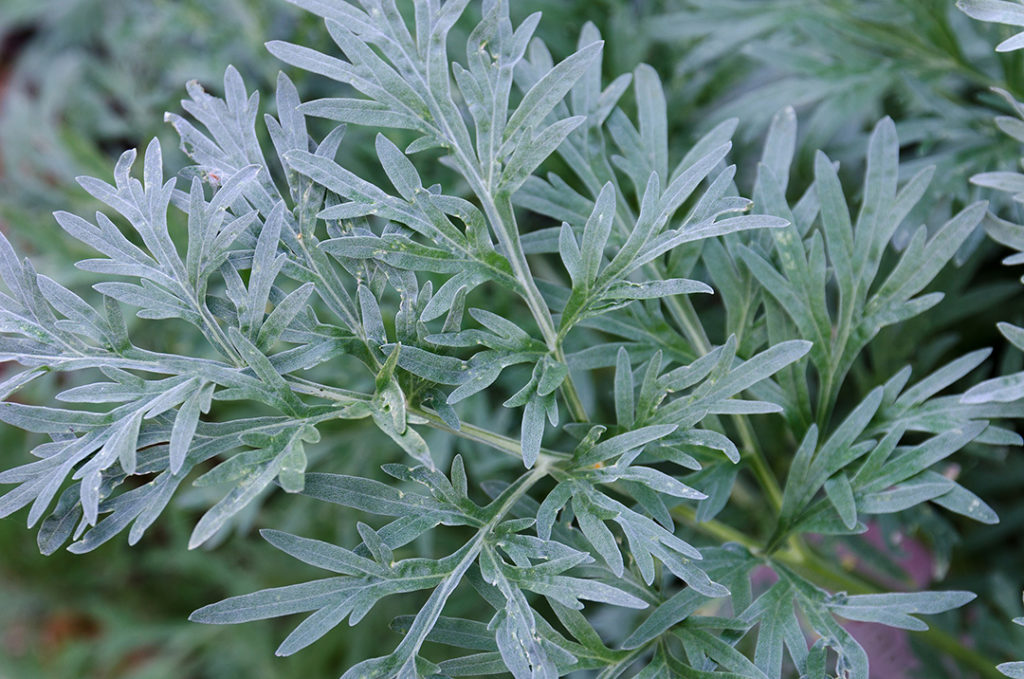
Kazakhstan
Wormwood
Artemisia absinthium

General Description / Cultural Significance
Wormwood, Artemisia absinthium, is a symbol of Kazakhstan. The bitter aromatic herb with a sage-like odor grows naturally in the desert, and Kazakhstan is approximately 85% desert. Many domestic animals raised in the country graze on woodworm, which causes the flavor of their meat to taste very specific. The taste is so distinctive that Kazakhstanis tend to dislike the taste of other meats. However, if a cow ingests wormwood and then produces milk, it is so strongly flavored that it is considered unfit for human consumption.
Wormwood is typically ingested as a tea or the extract from its stems and leaves is used. It is pain relieving and anti-inflammatory, often helpful in treating osteoarthritis and Crohn’s disease. It can be hallucinogenic and in large doses, can also be toxic. However, declining fear of its historical use in the beverage absinthe has opened the potential for more research to be done with regards to its medical potential. Artemisia absinthium is also thought to be antifungal and its antioxidant qualities mean there is potential for using it to fight cancer and Alzheimer’s.
Climate Change/Conservation Status
Kazakhstan is the ninth largest country in the world by territory and climate change is affecting the regions differently. The arid steppes and deserts are experiencing rising average temperatures, which are affecting the severity of their urban air pollution and the health of their people, as well as impacting their agricultural production. The spring wheat production is in rapid decline because of droughts, flooding, and fires and predictions are that it will decrease by 70% by 2030. Much of their problem is due to their own heavy dependence on fossil fuel and coal-based energy. Climate change is also expected to further affect access to water resources, and the accelerated desertification has the potential to lead to greater biodiversity loss.
As of August 2021, Kazakhstan is in the middle of one of the worst droughts in a long time. Food and water have been exhausted in many areas, leading to the death of livestock. For many herders, the loss of these cows, horses, and sheep means the loss of their way of life and livelihood.
Alternate Names
Artemisia
Absinthe
Absinthium
Mugwort
Wormit
Wormwood
Sources
Evans, J. E., & Eckhardt, N., n.d. Artemisia absinthium. Center for Invasive Species and Ecosystem Health at the University of Georgia. [website]
Lachenmeier, D. W., 2010. Wormwood (Artemisia absinthium L.)—A curious plant with both neurotoxic and neuroprotective properties? Journal of Ethnopharmacology, [website] 131(1), pp. 224-227. DOI: 10.1016/j.jep.2010.05.062
Mission of the Republic of Kazakhstan to the United Nations. This statement can be found on the World Sensorium original website.
Pannett, R., 2021. Horse graves on the steppes as Kazakhstan is battered by one of the worst droughts in living memory. The Washington Post. [website]
US AID, 2021. Kazakhstan – Energy and Environment. US Aid of International Development. [website]
Wartenberg, L., 2020. What is Wormwood, and How Is It Used? Healthline Media. [website]

